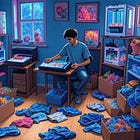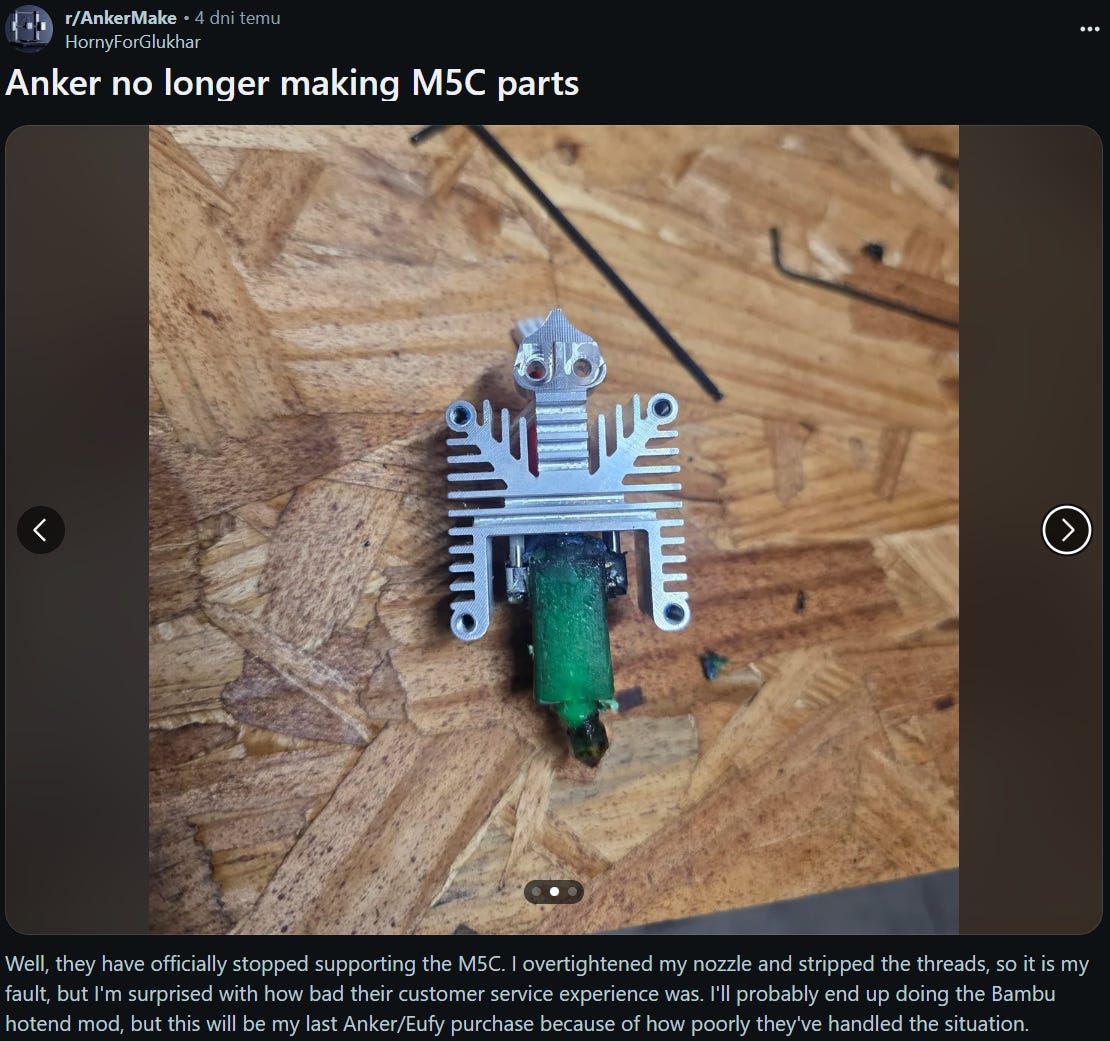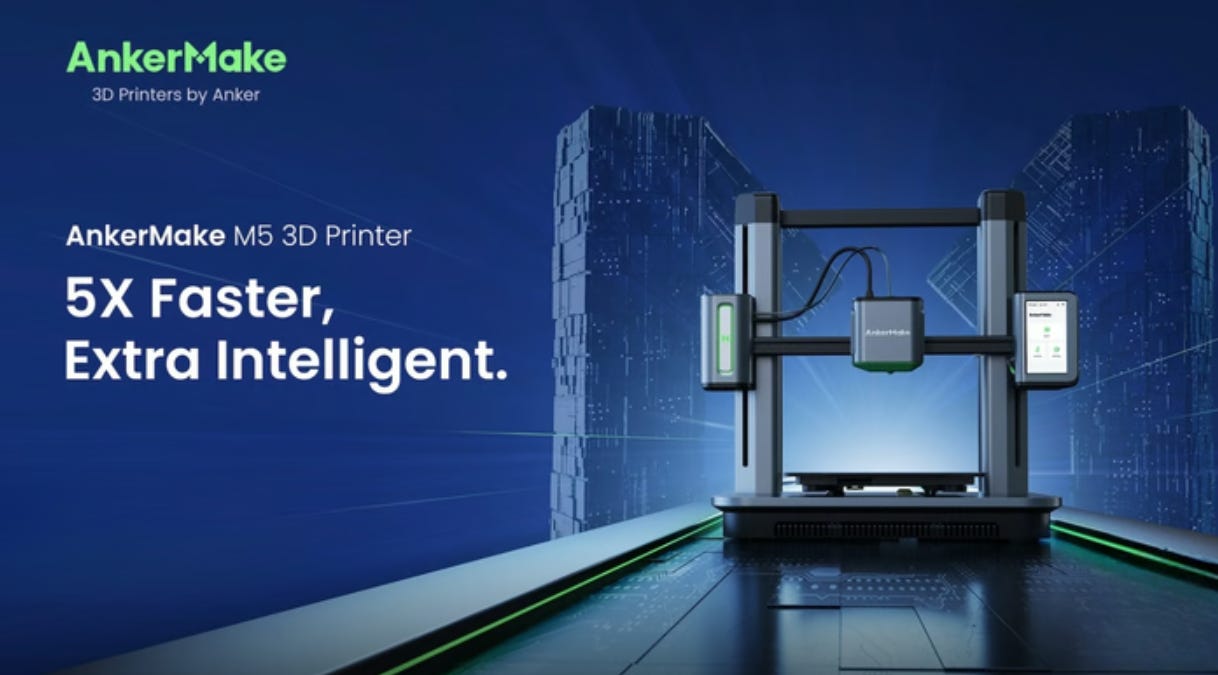Et tu, Brute? Anker is „pausing” the production and sale of 3D printers
3DP War Journal #56
Anker halts sales of its M5 and M5C 3D printers, as the EufyMake brand shifts focus exclusively to full-color UV printers!
Back in March, the company announced plans to create an "independent sub-brand," promising continued support for its existing 3D printer models. Now, the 3D printers section of its website is empty, and customers report that essential components like hotends and extruders are no longer available.
Supporters of the brand feel betrayed — like Julius Caesar looking into Brutus's eyes just before his death.
“So my 3D printer is now garbage?” — asks an angry Reddit user. Anker has officially confirmed: “Sales of 3D printers have been paused indefinitely.”
Is this the end of Anker’s journey in the 3D printing world?
This whole AM industry thing feels like a rather schizophrenic situation. On the one hand, I spent two weeks in China and saw it with my own eyes — the 3D printing market is booming. It’s in the strongest place it’s ever been. More 3D printers are being manufactured and sold now than at any other point in history.
On the other hand, it seems like not a month goes by without me reporting on yet another collapse or exit from the additive manufacturing business.
Just three weeks ago, I covered what was arguably the most significant case in recent months — the sale of TRUMPF’s AM division to the LEO III Fund, managed by the DUBAG Group. And that’s only scratching the surface.
Stratasys acquired the sole remnants of Nexa3D and Forward AM. BCN3D declared bankruptcy. Israeli Castor filed for liquidation. OpenBuilds shut down its operations entirely. Etsy modified its platform rules, effectively banning the sale of 3D-printed goods — a move that practically removes the platform from the sector.
And just last week, yet another shutdown occurred — this time Systemic Bio, the bioprinting venture created by 3D Systems on the foundations of Allevi, was closed down.
And now there's the Anker situation. It’s more complex because it involves a Chinese consumer electronics company — one that set records on Kickstarter with its 3D printers.
Last Friday, The Verge officially confirmed that Anker is suspending both production and sales of its 3D printers, along with certain replacement parts. This sparked a wave of outrage across social media.
It all began in March 2025 when Anker announced that it was spinning off its 3D printer division into a new sub-brand called eufyMake. Officially, the move was presented as a way to offer “comprehensive customer service and support” for users of the AnkerMake M5 and M5C — two models released over the past few years.
Shortly afterward, in April 2025, Anker surprised everyone with a completely new product under the eufyMake name: the full-color UV printer E1.
The UV printer launched on Kickstarter, and within just a few weeks it became the highest-grossing campaign in the platform’s history — raising over $46 million from nearly 18,000 backers.
The E1 is not a 3D printer in the traditional sense. It’s a UV-based device capable of printing realistic, raised 3D textures onto flat surfaces such as paper, glass, wood, metal, or leather. It uses specialized UV ink (CMYK + white + clear) and can create elevations up to 5 mm thick. It also supports printing on cylindrical objects via an optional rotary module.
I covered it here:
The eufyMake E1 has the potential to become a completely new category in consumer electronics, introducing UV printing technology to the mainstream for the very first time. It’s especially noteworthy as a natural complement to the 3D printing segment — a sector Anker had been involved in for the past three years.
Or rather… was.
Reports from The Verge, backed by user experiences shared on Reddit, suggest that the decision to spin off the brand was more likely a way of exiting the 3D printing market quietly than a sincere effort to continue it under a new banner.
eufyMake is no longer selling any 3D printers. The website lists no models — neither the M5 nor the M5C.
Moreover, crucial spare parts have disappeared, including the M5C’s hotend — one of the most commonly replaced components in any 3D printer.
Anker spokesperson Brett White confirmed to The Verge that sales of AnkerMake printers have been “paused indefinitely” and was unable to say whether the company or the eufyMake brand plans to release future models.
According to White, eufyMake “has not ruled out” designing new printers, but there are currently no active sales.
While eufyMake states that customers can still contact its support team for help, more and more users are reporting difficulties getting essential parts.
One Reddit user shared a message from EufyMake's technical support stating that the M5C hotend “has been removed from the offering due to limited inventory and is no longer available for purchase.” In response, the frustrated user asked, “So my printer is now useless because you stopped supporting it?”
This situation is especially frustrating because AnkerMake printers were supposed to represent a revolutionary leap forward in consumer 3D printing. The M5 model, first introduced through a crowdfunding campaign in 2022, promised breakthrough features like print speeds of up to 500 mm/s, automatic bed leveling, an AI-powered failure-detection camera, and a modern interface.
Unfortunately, some users encountered significant issues — from faulty calibration and excessive noise to cooling system failures and problematic software. The AI camera often failed to perform as expected and was eventually disabled by default in firmware updates.
Despite these setbacks, the company attempted to salvage its reputation by releasing the more affordable M5C model. It featured a simplified design with no screen or camera but retained many of the core functionalities of its bigger sibling.
For context, the AnkerMake M5 was officially unveiled on April 6, 2022, on Kickstarter. By May 21, 2022, it had raised an impressive $8,881,095 from 11,313 backers. The campaign launched with a symbolic funding goal of $50,000, which was exceeded within hours. The project was marketed as the answer to the common frustrations of beginner users: slow printing speeds, complex setup, and frequent print failures.
In addition to its high-speed capabilities, the M5 offered 49-point automatic leveling, an aluminum chassis, a metal extruder, and a built-in AI camera to monitor the printing process. The company also promised a V6 system — a color head for multicolor printing — which, however, never entered mass production.
The M5 attracted a lot of attention from media outlets and enthusiasts, but issues soon emerged. Users reported problems with first-layer adhesion, inconsistent print quality, excessive noise, and unreliable AI features.
In 2023, Anker released the M5C, intended to be a more accessible version of the M5. Priced at around $400, it was smaller and easier to use but also stripped of features like the screen and camera.
Although the M5C was more positively received for its overall stability, the company gradually reduced its availability — until, by early 2025, it disappeared entirely from the product lineup.
Now, 3D printer owners are left to deal with their problems alone. It’s worth noting that despite its early success on Kickstarter, the M5C never achieved mainstream traction on the same level as Bambu Lab (which launched around the same time), Creality, or Elegoo.
One can only hope that the E1 doesn’t share the fate of Anker’s 3D printers. Nonetheless, Anker’s 3D printing customers have every right to feel betrayed, as the expiration of the product line didn’t even last six months.
As for the 3D printing industry as a whole — this is yet another refugee from the land of additive manufacturing.
But on the other hand, maybe that’s a good sign.
In AM, only the best are staying.
#7. Aibuild and Massive Dimension launched MD Software
Aibuild and Massive Dimension have unveiled MD Software, merging AI-powered automation with industrial extrusion tech. This powerhouse combo delivers parametric slicing, thermal analysis, and automated design tools specifically optimized for Massive Dimension's large-format 3D printers. The cloud-based platform promises factory-floor integration without disruption.
READ MORE: www.tctmagazine.com
#6. Stratasys integrated Fixturemate into GrabCAD Print Pro 2025
Stratasys has integrated Trinckle's Fixturemate into GrabCAD Print Pro 2025, revolutionizing fixture design for industrial 3D printing. The update eliminates CAD dependencies, allowing operators to create production-ready fixtures without specialized skills—cutting design time from days to hours. New features include 3D textures for improved part quality, hollowing tools for material savings, and parallel print preparation for optimized printer use.
READ MORE: www.3druck.com
#5. Materialise published mixed Q2 results
Materialise reported mixed Q2 2025 results, with revenue declining 5.8% to €64.83M due to Manufacturing (-24.9%) and Software (-12.1%) segment weakness. However, gross margins improved to 58.3%, driven by cost control. The Medical segment shined with 16.7% revenue growth (€32.85M) and a 32.7% EBITDA margin, fueled by demand for patient-specific solutions. While geopolitical challenges impacted industrial demand, sequential EBIT improvement suggests stabilization. Medical now represents over 50% of total revenue.
READ MORE: www.voxelmatters.com
#4. Skuld's Lightning Metal Machine made debut at University of Tennessee
Skuld LLC has sold its first Lightning Metal LM 16 machine to the University of Tennessee, marking a milestone for its Additive Manufacturing Evaporative Casting (AMEC) technology. The low-cost system enables metal casting (aluminum, steel, iron, etc.) using scrap materials and desktop 3D printers, offering faster production than sand casting. Ideal for defense and remote applications, the university will use it for alloy research and workforce training, potentially paving the way for military adoption.
READ MORE: www.3dprint.com
#3. 3MF Consortium achieved ISO standard status for Next-Gen 3D Printing File Format
The 3MF Consortium has reached a major milestone as its XML-based 3D Manufacturing Format (3MF) officially becomes an ISO standard (ISO/IEC 25422:2025). Developed to replace outdated formats like STL, 3MF supports color, materials, textures, and complex structures through extensions, while offering smaller file sizes. Backed by industry leaders including Microsoft, HP, and Siemens, the format is now supported by over 100 software applications.
READ MORE: www.voxelmatters.com
#2. 3D Systems closes Systemic Bio
3D Systems has closed Systemic Bio, its vascularized tissue bioprinting subsidiary, citing profitability priorities. The spin-off had developed high-throughput h-VIOS platforms producing 6,000 vascularized hydrogels/month for pharma testing, filing seven patent families. Founder Taci Pereira, who spearheaded the project after 3D Systems acquired her previous company Allevi, acknowledged the "massive investment" required in a challenging market. The closure leaves questions about commercialization pathways for scalable bioprinting solutions despite proven technical capabilities.
READ MORE: www.3dprint.com
#1. Dyndrite signed multiyear deal with Ursa Major
Ursa Major will integrate Dyndrite's LPBF Pro as its core metal AM software after a 6-month evaluation proved superior performance in support optimization and process control. The partnership focuses on scaling hypersonic propulsion systems through Dyndrite's scriptable platform, which enables automated parameter development and knowledge capture. The collaboration aims to overcome legacy bottlenecks in part qualification and multi-machine production for defense and space applications.
READ MORE: www.3dprintingjournal.com








